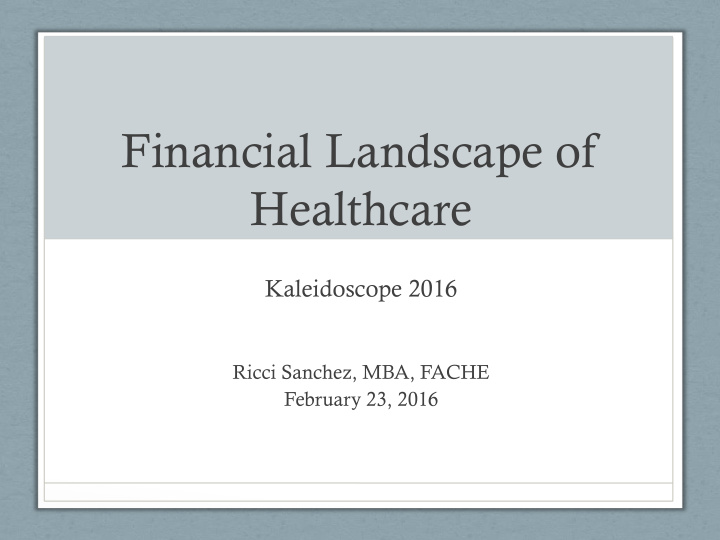



Financial Landscape of Healthcare Kaleidoscope 2016 Ricci Sanchez, MBA, FACHE February 23, 2016
History of Healthcare Reimbursement – before 1920 • Before 1920, the amount of lost wages due to illness were 4 times the expenses to treat it Many physicians billed families a fixed amount per year to take • care of all the family’s medical needs • The Flexner Report (1910) redefined the paradigm of North American medical education • Recommendations for stricter entrance requirements, tougher standards, more rigorous medical training and physician licensure resulted in closure of medical schools and a sharp drop in number of physicians • The law of supply and demand • Fewer physicians = increased cost of physician services • Advances in medical technology also led to increased costs
History of Healthcare Reimbursement – 1930’s – 1960’s • Early insurance plans were prepaid hospital plans • Blue Cross (hospitalization) • Blue Shield (physician services) • The rise of employer-based insurance plans • If people were healthy enough to work, they were a healthier group overall and a better actuarial risk • Tax benefits • LBJ Administration’s passage of Medicare Parts A & B (1965)
History of Healthcare Reimbursement – 1970’s - 1990’s Managed Care • • Passage of the Health Maintenance Organization (HMO) Act of 1973 • The collaborative relationship between physicians, hospitals, and patients was transformed into a competitive marketplace • The goal was to contain costs and increase quality, reducing the unsustainable fee for service model • Pay to keep patients well, not pay to treat them when they’re sick • Those that tried to improve outcomes found their incomes dropping • Short-range focus was to save money – HMOs remained solvent by allegedly denying care • Failure of the Clinton Plan was due largely to a rushed approach and poor political strategy
History of Healthcare Reimbursement – 2000’s • Health Reform lay dormant until Obama was elected in 2008 • Passage of the Patient Protection and Affordable Care Act in 2010 • Medicaid Expansion (optional based on Supreme Court decision in 2012) • State- based exchanges or “marketplaces” • Tax credits and subsidies for smaller employers to offer coverage • Extension of dependent coverage until age 26
PPACA & Women’s Health • Maternity & newborn care • STI & gestational diabetes screenings • Breastfeeding support • Mental health screening and treatment, postpartum depression education and support • Well woman exams • Annual mammograms at age 40 • HPV vaccine & testing • FDA approved prescription contraceptives & family planning (with certain religious exemptions) • Domestic violence screening • Sex education programs • Mental health screening and treatment, postpartum depression education and support
Outlier Protection • Allows for reimbursement of extremely variable costs when reimbursements are fixed at a global rate • Additional per diem payment based on LOS threshold • % of costs above base rate when cost threshold is reached • For outlier cases, Medicare compares hospital- specific cost-to-charge ratios to covered charges to determine whether the costs of the case exceed the fixed-loss outlier threshold • Nevada, Florida, California & Texas are among the lowest (higher charges compared to costs) • Maryland is the highest (lower charges compared to costs) Source: http://www.cms.gov/Medicare/Medicare-Fee-for-Service-Payment/AcuteInpatientPPS/outlier.html. Accessed February 18, 2013.
Financial Management: Operating Statement Review
What Tools do you need to be ready for Value Based Payment? • Understand your operating statement; look at it every month • Understand your variances and explain them thoughtfully; minimize them when you can • Understand flex budgeting • Understand how your documentation affects coding and reimbursement; consistently improve • Pay attention to the line-item detail; errors are more common than you think
What Tools do you need to be ready for Value Based Payment? • Create a healthy mindset toward standardization • Teach your staff to look for non-standardized products, overstocking • Create a culture of relentlessly eliminating waste • Monitor compliance with care protocols
What Tools do you need to be ready for Value Based Payment? • Understand your data; if you need it portrayed differently, ask • If you discover ideas to contain costs, speak up • Never lose sight that the patient comes first • Patient satisfaction leads to healthy financial performance • Even more so under patient cost sharing (e.g., higher deductibles) and value based payments
Future of Healthcare Reimbursement • Value-Based Reimbursement • What is value? Quality Cost • How is this different than managed care? • Incentivizing providers to reduce spending for a defined patient population through receipt of net savings • Alternative Payment Models: Shared Savings, Bonus Pools, Care Management Incentives, Merit Based Incentives
The Scoring Trend HRRP • HAC Reduction Program • IQR • OQR • • PQRS • HCAHPS • CGCAHPS • Medicare Star Ratings for Nursing Homes and Home Health • Meaningful Use – rolling up as a component of “MIPS”
Other Trends • Shifting Revenue Mix • A higher % of patients are covered by public insurance; reimbursements are traditionally lower than commercial payers • Baby boomers are aging into Medicare Employers designing and managing their own health plans • • Benchmarking / Transparency • (Hospital Compare, Physician Compare, Star Ratings, HealthGrades, RateMDs)
Brown, B. & Crapo, J. (2014). The Key to Transitioning from Fee-for-Service to Value-Based Reimbursement. Accessed February 3, 2016, healthcatalyst.com .
Questions?
Recommend
More recommend